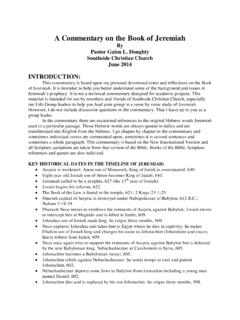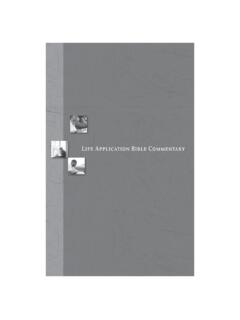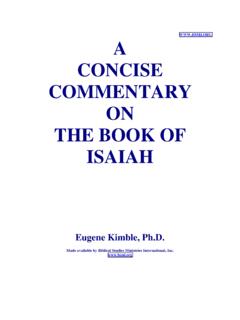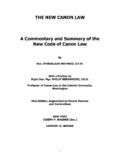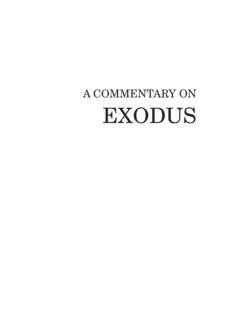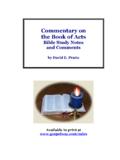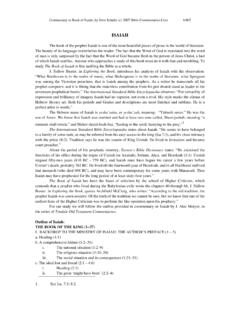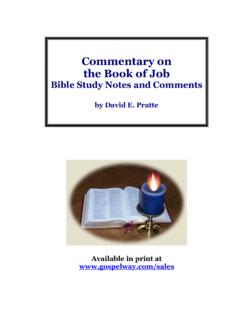Transcription of A Commentary on the Book of Ezekiel - southsidespokane.org
1 A Commentary on the book of Ezekiel By Pastor Galen L. Doughty Southside Christian Church December 2014. INTRODUCTION: This Commentary is based upon my personal devotional notes and reflections on the book of Ezekiel . It is intended to help you better understand some of the background and issues in Ezekiel 's prophecy. It is not a technical Commentary designed for academic projects. This material is intended for use by members and friends of Southside Christian Church, especially our Life Group leaders to help you lead your group in a verse by verse study of Ezekiel . However, I do not include discussion questions in the Commentary . That I leave up to you as a group leader. In the Commentary there are occasional references to the original Hebrew words Ezekiel used in a particular passage. Those Hebrew words are always quoted in italics and are transliterated into English from the Hebrew. I go chapter by chapter in the Commentary and sometimes individual verses are commented upon, sometimes it is several sentences and sometimes a whole paragraph.
2 This Commentary is based on the New International Version and all Scripture quotations are taken from that version of the Bible. Books of the Bible, Scripture references and quotes are also italicized. KEY HISTORICAL DATES IN THE TIMELINE OF Ezekiel : King Jehoiachim of Judah becomes a Babylonian vassal, 605. Jehoiachim rebels against Nebuchadnezzar; he sends troops to raid and punish Jehoiachim, 602. Nebuchadnezzar deports some Jews to Babylon from Jerusalem including a young man named Daniel, 602. Jehoiachim dies and is replaced by his son Jehoiachin; he reigns three months, 598. Nebuchadnezzar captures Jerusalem after a siege and deports Jehoiachin, his mother, and many of the leading citizens of Jerusalem, including the young priest Ezekiel ; he puts Jehoiachin in prison upon arrival in Babylon, 597. Nebuchadnezzar installs King Jehoiachin's uncle Mattaniah, son of Josiah as King of Judah and changes his name to Zedekiah, 597. Zedekiah rebels against Nebuchadnezzar and the Babylonians invade Judah and lay siege to Jerusalem, January 588.
3 The Babylonians breach the walls of Jerusalem, July 18, 586; Zedekiah flees the city in the night and heads toward Jericho where he is captured and taken to Riblah in Syria, Nebuchadnezzar's headquarters. There his sons are killed before him, his eyes put out and he is taken to Babylon in chains where he dies, July 586. Nebuzaradan, captain of Nebuchadnezzar's guard comes to Jerusalem with orders to burn the city to the ground. This he does, taking all the sacred objects of the temple to Babylon as booty. He burns the temple and tears down Jerusalem's walls. He also 2. deports much of the elders and leading officials of the city who are left alive, executing some at Riblah, Nebuchadnezzar's headquarters, August 586. Nebuzaradan returns to Jerusalem and takes another small group of Jews captive to Babylon, 582. Evil-Merodach, King of Babylon, frees Jehoiachin from prison and gives him a place at the king's table, 561. Babylon falls to Cyrus the Great of Persia, October 539. Cyrus decrees that the Jews of Babylon are free to return to Jerusalem and rebuild the temple of the Lord, 538.
4 The second temple is completed and dedicated, March 12, 516, 70 years and 7 months after it was destroyed. KINGS OF JUDAH & THEIR REIGNS DURING Ezekiel 'S LIFETIME: Josiah (640-609). Jehoahaz (609 3 months). Jehoiachim (609-598). Jehoiachin (598-597 3 months). Zedekiah (597-586). Fall of Jerusalem and Judah July August 586. OUTLINE OF Ezekiel : (Note: This outline is modified from the outline in the NIV Study Bible.). I. Prophecies of Judgment against Israel Chapters 1-24. A. Ezekiel 's Inaugural Vision and Call: 1:1-3:27. B. Symbolic Acts Portraying the Siege of Jerusalem: 4:1-5:17. C. Prophecies Explaining Divine Judgment: 6:1-7:27. D. Vision of the Corrupted Temple: 8:1-11:25. E. Symbolic Acts Portraying Jerusalem's Exile: 12:1-28. F. Prophecies Explaining Divine Judgment: 13:1-24:27. II. Prophecies of Judgment Against the Nations Chapters 24-32. A. Against Ammon: 25:1-7. B. Against Moab: 25:8-11. C. Against Edom: 25:12-14. D. Against Philistia: 25:15-17. E. Against Tyre: 26:1-28:19.
5 F. Against Sidon: 28:20-24. G. A Note of Promise for Israel: 28:25-26. H. Against Egypt: 29:1-32:32. III. Prophecies of Consolation for Israel Chapters 33-48. A. The Watchman: 33:1-20. B. Jerusalem's Fall Reported and Explained: 33:21-33. C. The Lord as the Good Shepherd: 34:1-31. D. Prophecies Against Edom: 35:1-15. E. Consolation for the Mountains of Israel: 36:1-15. 3. F. Summary of Ezekiel 's Theology: 36:16-38. G. Vision of National Restoration (Valley of the Dry Bones): 37:1-14. H. The Final Battle with Gog and Magog: 38:1-39:29. I. The Vision of the Renewed Temple and Worship: 40:1-48:35. A NOTE ABOUT CHRONOLOGY: You may note that some Bibles have a slightly different chronology for the reigns of the last kings of Judah and the date of the fall of Jerusalem. I follow many scholars who date the fall of Jerusalem as 586BC. Other scholars date the city's fall as 587. The discrepancy comes in the dates for the reigns of the kings plus trying to synchronize those dates with extra-Biblical sources like the court records of the Babylonian kings.
6 There is also some debate about the differences between a king's reign as defined by the years of his life and a king's reign as the actual time he ruled from the throne of David, including time as the regent of his father who was still living. The discrepancies are small and are of no major theological significance, however, your Bible may be slightly different than the chronology used in this Commentary and I wanted to clarify the differences. THE Commentary : Chapter 1: 1:1-3 - These verses are the introduction to Ezekiel and give us the date of the beginning of his prophetic career. Ezekiel began his ministry when he was thirty years old, in the fifth year of the exile of King Jehoiachin, which would have been 592BC. Ezekiel , along with his wife, was part of the exiles taken to Babylon by Nebuchadnezzar in 597. See 2 Kings 24. Nebuchadnezzar's first exile of the Jews was the most important exile because most of Judah's leadership along with her king were taken to Babylon. Many priests were taken and Ezekiel was one of those priests.
7 Ezekiel was 25 when he was taken captive which meant he had entered into his priestly apprenticeship but was not yet a full priest with regular duties in the temple. He would be learning all that was necessary to fulfill his priestly calling. Thus he exhibits throughout his prophecy a thorough knowledge of the temple and its rituals. His thirtieth year would have been the time when he became a full priest and took up his duties in the temple in Jerusalem. Instead God calls him as his prophet in a foreign land. He is the son of Buzi a priest who is otherwise unknown. Ezekiel therefore was of the tribe of Levi and a descendant of Aaron and his sons. Ezekiel was on the banks of the Kebar River when the Word of the Lord came to him. He had been an exile for five years. The Kebar River is probably a reference to what was called the Great Canal, nari kabari in Babylonian. Many Jewish exiles lived nearby in a village called Tel- Abib. Ezekiel , using the Hebrew calendar and his age, gives the date of his first prophecy as the fifth day of the fourth month of his thirtieth year.
8 The NLT transposes the Hebrew calendar into our calendar using Babylonian records along with the biblical data and dates his first prophecy as July 31, 593. Ezekiel 's entire mission was to prophesy to the exiles in Babylon. There is no evidence that he ever went home to Jerusalem. His career is coterminous with Jeremiah's. Whereas Jeremiah prophesied to the people of Jerusalem, Ezekiel preached solely to the people in Babylon who lived in exile. The first part of the book from chapters 1-24 are prophecies given to the exiles before the fall of Jerusalem and warn the people that God's judgment is coming and not to think they will be going home soon. In this Ezekiel is similar to Jeremiah in that he is attacking the official 4. theology of the kings and priests that many of the exiles still believed even though they were now in Babylon. Chapters 25-32 are prophecies against the nations similar to Jeremiah 46-51. and Isaiah 13-27. It is impossible to tell when Ezekiel was given these prophecies.
9 However, they do mark a division within Ezekiel 's book between the two major phases of Ezekiel 's ministry. Chapters 33-39 are written to the surviving exiles after Jerusalem's fall in which Ezekiel tries to build up the Jews living in Babylon and help them remember they are still the people of God. This section contains the famous prophecy of the Valley of Dry Bones stating that God would bring a united Israel back to the land and renew his people. The last section, chapters 40-48, was written sometime later than chapters 33-39. 33:21 was written in the 12th year of the exile which would have been 585. 40:1 was written in the 25th year of the exile which would have been 572. Since this is the latest part of Ezekiel 's prophecy his career spanned from 592 to 572, some twenty years, all in Babylon. Ezekiel says he was on the banks of the Kebar River when the heavens opened and he saw visions of God. His whole prophecy can be described as visions and his style is very different from the other prophets.
10 He begins however with his call and the vision of God in the sky above him, seated upon his throne with the cherubim around him. The key to understanding Ezekiel is to note that he both hears from God and sees a vision of God in Babylon and not in Jerusalem or the Promiseland. God is therefore everywhere and can be worshipped everywhere, even by the exiles in captivity. They do not need a temple or to be in the land to know and worship God. Ezekiel 's ministry helps lay the foundation for the Jews' faith for the centuries to come leading up to the birth of Jesus. He prepares the way for the Diaspora of the Jews and helps them redefine who they are as God's chosen people in the world. 1:4-9 - Ezekiel , standing by the Kebar Canal or River, looks up and sees a huge thunderstorm coming from the north. This would have been an extremely rare occurrence for late July in southern Iraq. The weather at that time of the year in the area around Babylon is almost always clear and very hot, usually 100 degrees plus, much like the American Southwest.
